Royal Cortissoz
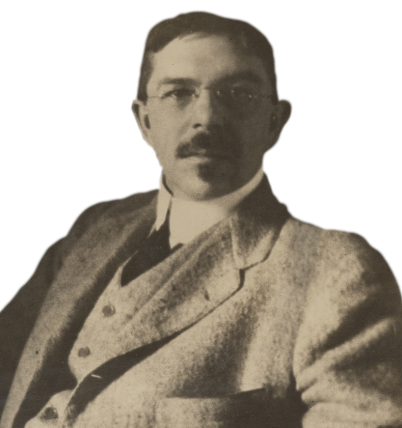
Royal Cortissoz, 1920
THE ART CRITIC:
Royal Cortissoz
and THE ARTIST:
Robert Strong Woodward
Royal Cortissoz, (10 February 1869 - 17 October 1948) was an art historian and the art critic for the New York Herald Tribune.
To the best of my knowledge the famous art critic of the day, Royal Cortissoz, never visited the famous New England landscape artist, Robert Strong Woodward or his studio.
But there was much correspondence between the two of them, each often criticizing the other. For some reason, which even today I do not understand, RSW talked about these letters with me, a then teenager, who had little understanding or appreciation of their discussions and disagreements. Since RSW died I have searched the nooks and crannies of the Woodward studio, the attics and the home and have uncovered only a very few of the letters which passed between them. I have the feeling that RSW kept only the letters with which he agreed and destroyed in the studio fireplace those with which he was displeased.
Through it all the two men, the artist and the critic, deeply respected and admired each other. Probably each was right!
N.Y. HERALD TRIBUNE - Sept. 4, 1932
"An Exhibition Amid the Green Mountains"
By Royal Cortissoz
Manchester Vt.
August 31, 1932
A salient instance is provided by one of the landscapes which do more than paintings in any other category to give the show its character. This is the Mount Greylock in December by Robert Strong Woodward. I indicated just now that there were no singular spots in the collection but I had forgotten for a moment Mr. Woodward's fine panorama of mountain and valley. It detaches itself beautifully from its surroundings by virtue of the broad impression it conveys of a majestic scene, and through the quality it has of a subject apprehended with genuine emotion. Incidentally, there is some fine drawing in the work. Mr. Woodward shows two other good pictures but the Mount Greylock is unquestionably his chief contribution and one of the arresting episodes of the occasion. What has impressed me in his art, and that of more than one of his colleagues, is the fusion of the large, even grand nature of the scenery of this lovely part of the world with its more intimately beguiling traits. These mountains are imposing and have an air of unbroken stillness in which there is a strain of sadness, but, as the philosophical squire said to Dr. Johnson, "Cheerfulness is always creeping in."
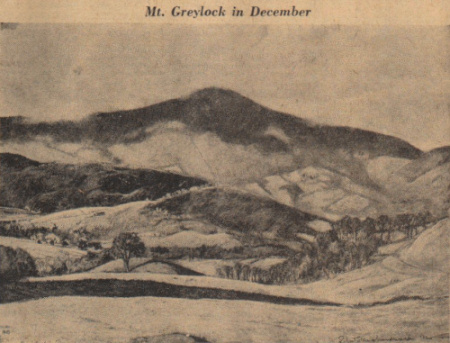
Mount Greylock in December
New York Herald Tribune, Sept, 1932
"Mr. Woodward's picture Mount Greylock in December was the one canvas that stood out from the others---that 'made a hole in the wall'--- as the saying is, in the exhibition this summer at Manchester, Vt. What has impressed me is his fusion of the large even grand nature of the scenery in this lovely part of the world with its more intimately beguiling traits."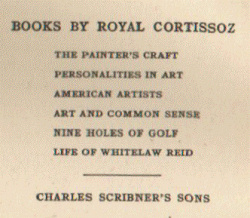
Books by Royal Cortissoz
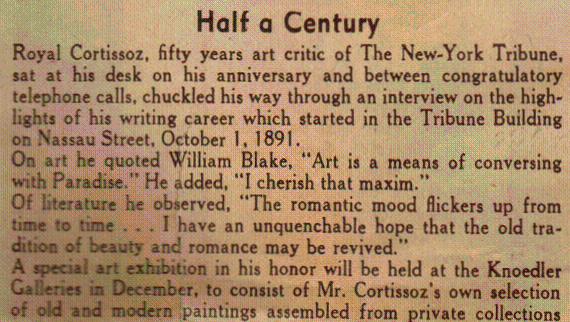
Newspaper article marking Royal Cortissoz 50th anniversary as art critic
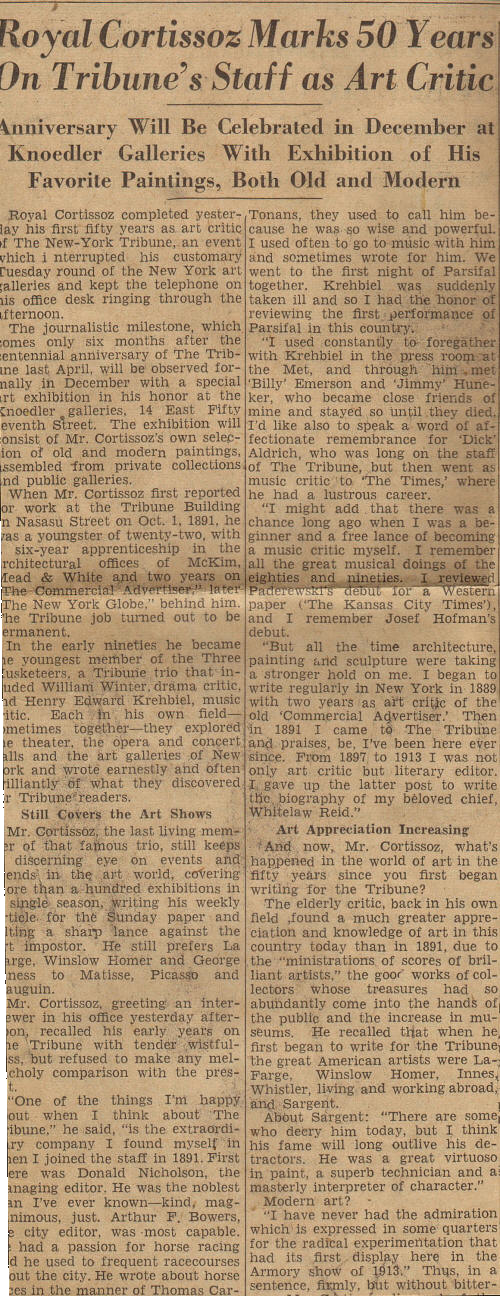
Newspaper article marking Royal Cortissoz 50th anniversary as art critic
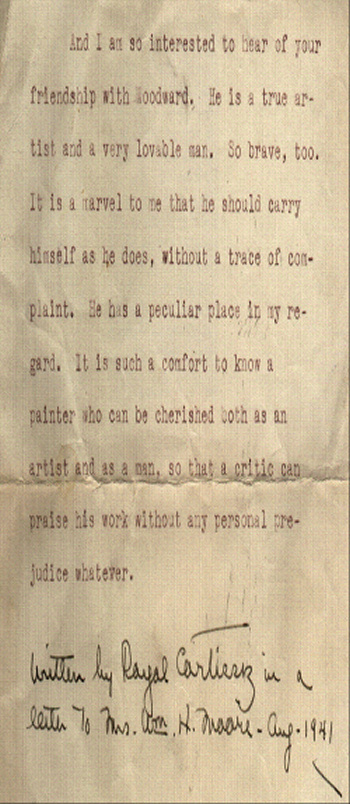
Letter from Royal Cortissoz to Ada Moore
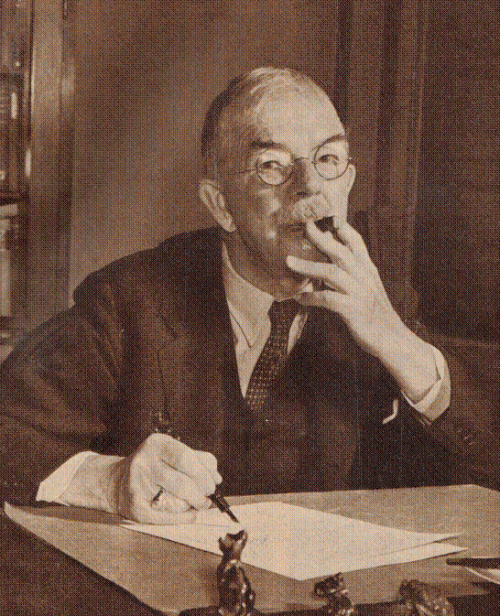
Letter from Royal Cortissoz to Ada Moore
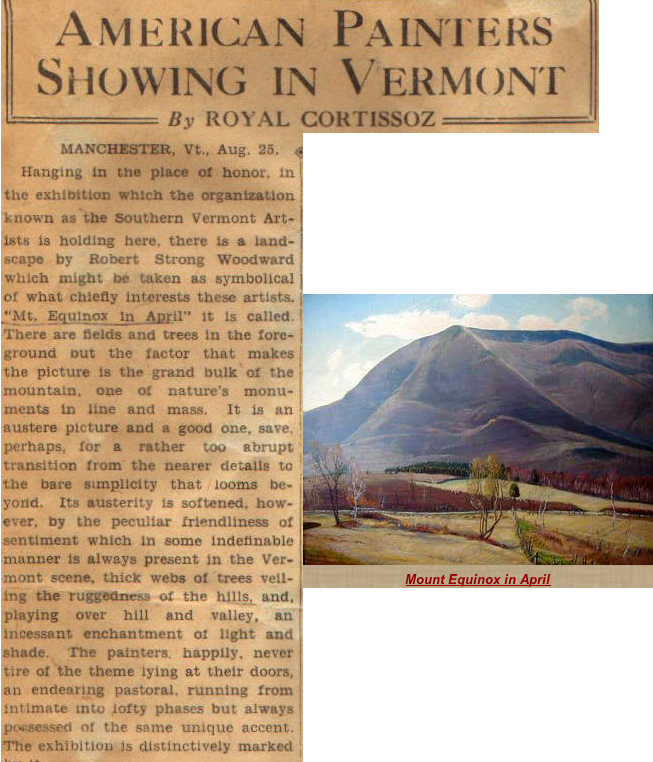
Royal Cortissoz article about the Southern Vermont Artists Association Exhibition, Manchester, VT
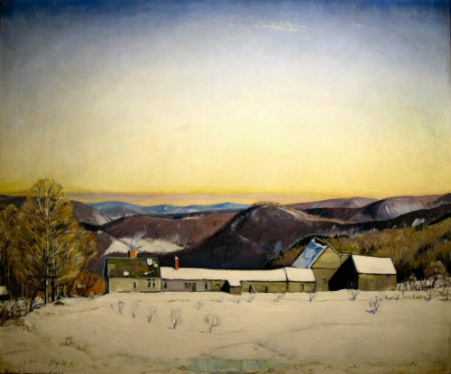
Courage And Peace
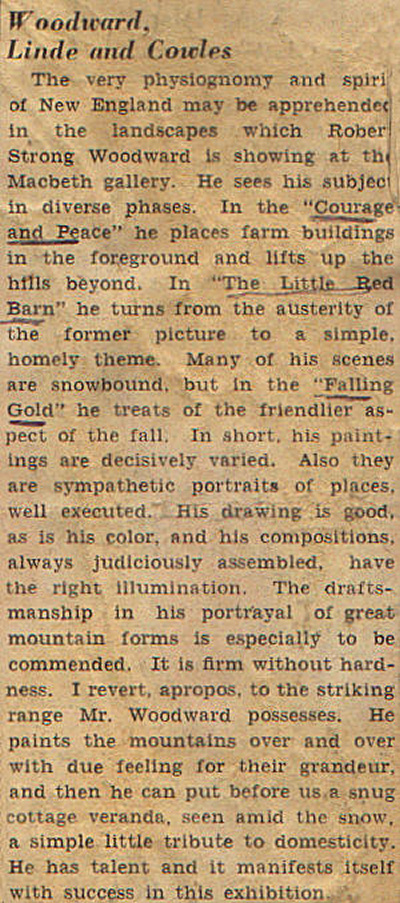
The painters of Southern Vermont
by Royal Cortissoz
New York Herald Tribune.
Sunday August 25, 1940
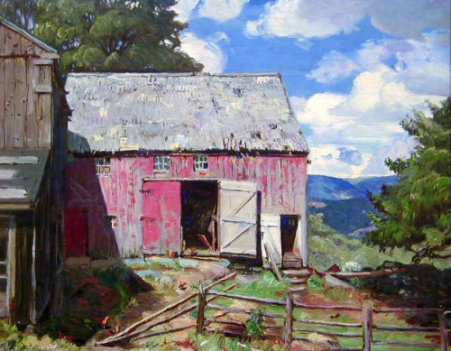
The Little Red Barn
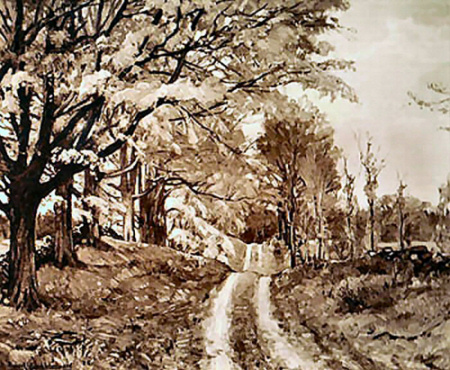
Falling Gold
![Dear Woodward:
A happy new year to you! I begin the new year with a letter to you which I am very glad to write. I cannot too soon disabuse your mind of any idea that a thousand counter criticisms, from any source, could consciously or unconsciously affect my attitude toward your work. That is determined solely by the work itself. I was merely amused by the letter to which Mr. Macbeth referred in his letter to you. Obviously it came from some admirer of yours but whoever it was was very foolish. I had been talking about quality in paint, a term which you and I perfectly well understand. The letter writer retorted by dragging in rhythm, a totally different thing. Naturally I smiled but I was glad to have the item printed, if only to show that you have your staunch partisans.
I, as you know, am also one of them. I have a well founded belief in your work. Since you know this and since you write so frankly I will tell you in my turn a little more of what I was driving at. There is a delicate moment in which the insensate paint, under the artist's hands, takes on a patina that makes it a little more than paint, makes it a sensuously beautiful surface. Time, as you know, often accomplishes this subtle mutation but it is within the artist's power to achieve it. I believe it is within your power and I urge you to meditate upon it. As a matter of fact I greatly admired the construction of the big mountain picture. Just because of its importance I paused there upon the qualities I had raised. I was sorry to find the mountain there painty, as I said, when I felt that by longer manipulation of your tones you might have got the quality of which I venture to speak so much. It is a terribly important element, this of giving a richer density, a more personal accent, to mere painted surface. But enough of my moralizing. I only indulge in it because I feel that we are friends and that you will take in good part my endeavor to suggest what I think would heighten the value of your already valuable work.
And grasp, too, really grasp, the fact that I had not thought of you as inspiring the letter in question and couldn't possibly be influenced by it in any way.
I am so sorry about the tragedy of your faithful nurse. I can realize what it must mean to both of you and I deeply sympathsize. I do hope the new year mends for you and brings more of brightness [sic] into your life. Meanwhile you have your beautiful work. May you wax stronger and stronger in that, going on from one success to another. Be sure that I shall watch out for what you do.
Sincerely,
Royal Cortissoz](photos/Cortissoz/Royal9.jpg)
Letter to RSW from Royal Cortissoz
Robert Strong Woodward
Shelburne Falls, Massachusetts
undated, probably around 19 or 20 April 1938
My dear Royal Cortissoz, greetings to you from Rob Woodward, with genuine hopes you have been well this winter. I begin this letter with a quoatation words of your own, printed in your review of John Whorf's exhibition, a week ago Sunday, April 10th.
"Today, coming forward again at the Milch Gallery, he (John Whorf) achieves even more decisively effects pointing to individualized ability, that gift is for the unhesitating and exact registration of the thing seen. There is nothing in the smallest degree photographic about his art, it is simply that he sees the truth and sets it down in unmistakable terms. Moreover, he sees the truth beautifully, so that he can take a prosaic subject, like the snow beleaguered house in Winter Morning and make a charming picture out of it.."
These are nicely written, chosen, words but I wonder if you realized (this is a rhetorical question for I well know you did not) that you were lauding Whorf, for copying in an underhanded, dastardly way, and passing it off as his composition and conception of truth my masterly painting of the truth, Country Piazza! Mr. Arkell now owns my canvas, bought by him two years ago for his Canajoharie Gallery.
A week ago Sunday, as I turned to the Artpage in the Herald Tribune (as I always do, to read your reviews) my eyes instantly fell to the illustration at the bottom of the sheet, with the first seconds thought of wonder, as to where Mr. Arkell could now be sending my Country Piazza canvas, that it should be illustrated only with the second seconds realization, that it was titled Winter Morning and stated below the picture that it was painted by John Whorf! It was a blow between the eyes! I was faint and dizzy and bewildered all day and it still seems to me like an eerie, uncanny thrust of fate, not to be believed. Yes, Whorf has tried to be clever with certain details, certain changes, so that if brought to bay he could say the picture, the composition, the conception is mine; he has changed the filigree gingerbread post capitals the most subtle touch in my canvas to Doric columns in his lefthand porch; he has left the figure off the settee; he has placed a chair and shadow where I had drying milk pails, he has shortened the woodshed ell with a glimpse of tree beyond it, and changed its doorway a bit; he has put a tile on the ell chimney, and some blinds on the upstairs windows, yes, yet despite all this he has not covered up one fraction to a perceptive, intelligent man, that he has copied and faked my masterly picture and thrown it before the world as his. The foreground alone is a copy almost line for line all so New England in its subtle touches the straggling wire fence at the left remaining from last years flower bed also at the right, the same group of stakes, the bush by the corner porch post the slanting cleared path running out of the foreground copied almost line for line. Realizing that it pulled the eye out a little bit too strongly to the right, I put in some cross shadows on the snow to hold the eye into the picture at that point; Whorf of course realizing this constructive point has done just the same somewhat different in arrangement the man has even put in two hen turkies and one gobbler, where mine strut. Look at the lefthand piazza chair back identical; look at the sagging slant of the righthand porch post against the dark of wood shed identical; look at the bit of background hill top to the right, where I put in a pine top to break the monotony of line identical. But of all things that hurt me most is the snow on the left piazza roof; almost identically in wave and proportion, Whorf has copied it even to the subtle touch which was mine of the wavey bottom line ~~~~~~ showing how the corrugated metal roof has so shaped the melting roof-drift.
--------- It all sickens as well as frightens me! I feel as if a strange man had been intimate with my wife! What to do? I would like to drag Whorf through the courts but the subtleties of the affair placed before the average jury is unthinkable. Besides I have no money to fight. I would like to come to New York, borrow the Country Piazza from Mr. Arkell, take it to the Milch Gallery place it under Whorf's copy, and ask the Milch people to realize what their brilliant showman is doing to gain his vaunted originality. But again I have no money for the fight.
My paintings have something beyond merely the representation of factual truth. All the tragedy, humor, and struggle of New England farm life are found in this painting of mine, Country Piazza. Critics have been slow to realize what I have to give, strangely slow but it will live down through later generations. Yes, this sounds to you like the twaddle of every man of every artist but I KNOW we shall see.
Where John Whorf did his copying I do not know. This canvas has been one of the most travelled pictures I ever had, until it came to rest with Mr. Arkell and even he has sent it to various important showings about the country, from Canajoharie. Aside from local exhibitions about the state, I showed it first six years ago at Manchester. It was invited to the Corcoran and to Pennsylvania; Harshe invited it to the Chicago World Fairs famous Exhibition. It went on tour of the Canadian museums of the Middle West museums and to Dallas, etc. It has been illustrated in nearly all the leading art magazines of the country and in many of the leading newspapers until it has nearly become the public's property but still, as you know, it is mine and what am I to do when another painter copies it and says it is his and receives praise for his expression of truth?
I wonder just what would be your advice?
In deep concern
Robert Strong Woodward
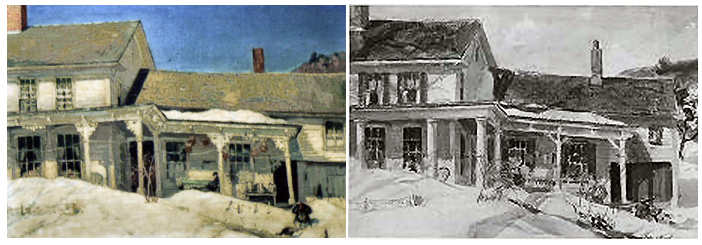
A Country Piazza (left) and Winter Morning by John Whorf (Right)

167 East Eighty-second Street
Dear Woodward:
I cannot forbear writing, to tell you how sorry I am that you have been ill. I write, too, from a fellow feeling, for I am until lately ill myself, with a complaint known as hyperacidity. Then I wanted to tell you how your further notes on the Whorf business have shocked [absorbed?] me again. Unconscious fiddlesticks! You may be sure I shall scrutinize with a new care the next things of his that come under my eye.
Yes, I hope we meet again at Manchester this summer, and that in the meantime your health may mend. Courage, mon ami. [And you have luck? Or Until you have luck?] of that.
Sincerely yours,
Royal Cortissoz
May 9, 1938
February 2011

